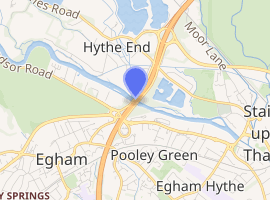M25 Runnymede Bridge
The M25 Runnymede Bridge is a motorway, A-road and pedestrian and cycle bridge built in the 1960s, 1980s and expanded in the 2000s carrying the M25 and A30 across the River Thames near the uppermost end of the Staines upon Thames and Egham reach of river. It is oriented north–south and is southwest of Heathrow Airport. It consists of the Runnymede Bridge and the New Runnymede Bridge; commonly referred to as one bridge.
M25 Runnymede Bridge | |
|---|---|
The New Runnymede bridge pictured from southern towpath immediately downstream | |
| Coordinates | 51°26′15″N 0°32′05″W |
| Carries | M25 motorway A30 road |
| Crosses | River Thames |
| Locale | Staines |
| Characteristics | |
| Design | Arch |
| Material | M25 Reinforced concrete A30 Encased steel |
| Height | 23 feet 0 inches (7.01 m)[1] |
| No. of spans | 1 |
| History | |
| Designer | M25 Ove Arup A30 Edwin Lutyens |

| |
It is one of three which carry motorways across the Thames, the others being the M3 Chertsey Bridge and the M4 Thames Bridge, Maidenhead. The Queen Elizabeth II Bridge at the Dartford Crossing is not classified as part of the M25.
History
Runnymede Bridge
Runnymede Bridge is a multi-span arch bridge at the uppermost end of the Staines upon Thames and Egham Reach of the River Thames: above Penton Hook Lock and below Bell Weir Lock. It opened in 1961 to carry the A30's Staines Bypass.[2][3]
Designs for the bridge were completed by 1939 by Sir Edwin Lutyens in concert with consulting engineer H Fitzsimons. World War II intervened, delaying construction by 20 years; Lutyens having died in 1944, his colleague George Stewart served as consulting architect, adopting the 1939 design. The bridge has a single span of 173.5 feet (52.9 m) across the Thames with 18 encased steel arches bearing the load of a concrete deck. There are two smaller spans, on land, at the abutments, taking the total length to 415 feet (126 m). As built, it had a width of 100 feet (30 m). The architectural treatment of the bridge was considered of great importance because of its proximity to Runnymede (the water-meadow) and the structure is finished with hand-made brick facings, white cement and Portland stone.[4] Until the 2013 reconstruction of Walton Bridge this was the first single-span bridge (i.e. without piers) over the Thames upstream, there being none in London or the estuary.[2]
New Runnymede Bridge
The New Runnymede Bridge forming its eastern half was designed by Ove Arup and Joanna Kennedy and built in 1978[5] to complement the earlier western half of the crossing, also simply named the Runnymede Bridge.[2][6] It is a single arch bridge of approximately the same form, but is made up of a series of parallel concrete frames: these allow light to penetrate upwards underneath and transfer loads vertically to avoid disturbing the foundations of the westerly bridge companion. In the first decade of the 21st century the motorway bridge was widened to five lanes each way, the widest in Britain. In addition, the A30 has two lanes each way, making a total of fourteen traffic lanes plus a pedestrian pavement on the eastern side.
See also
- Crossings of the River Thames
Notes and references
- Notes
- References
- River Thames Alliance. Bridge heights on the River Thames.
- "M25 Bridges". The Motorway Archive. Archived from the original on 29 August 2012.
- "Runnymede Bridge". Structurae. Retrieved 27 February 2017.
- Cracknell, Donald William (July 1963). "The Runnymede Bridge". Proceedings of the Institution of Civil Engineers. 25 (3): 325–344. doi:10.1680/iicep.1963.10592.
- Peter Jones (2006). Ove Arup: Masterbuilder of the Twentieth Century. Yale University Press. pp. 310–. ISBN 0-300-11296-3.
- OS Map with Listed Structures nearby (not including the bridge as it is not listed) and official names marked Archived 2012-04-24 at the Wayback Machine
| Next crossing upstream | River Thames | Next crossing downstream |
| Albert Bridge (road) | M25 Runnymede Bridge Grid reference: SU967772 |
Staines Bridge (road) |
| Wikimedia Commons has media related to Runnymede Bridge. |